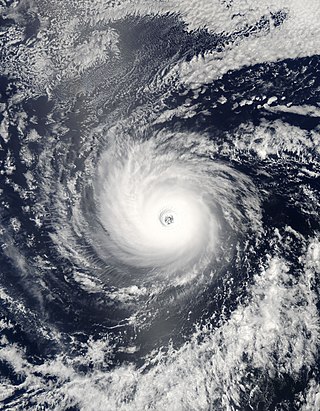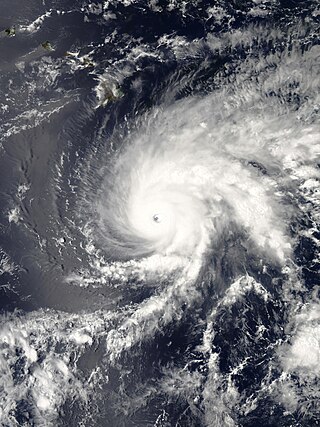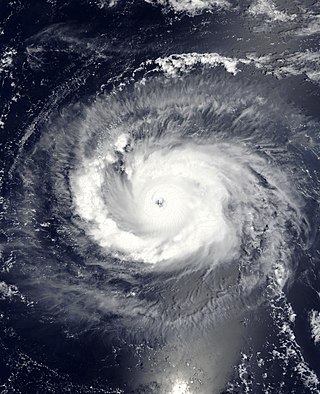
Hurricane Iniki was a hurricane that struck the island of Kauaʻi on September 11, 1992. It was the most powerful hurricane to strike Hawaiʻi in recorded history, and the only hurricane to directly affect the state during the 1992 Pacific hurricane season. Forming on September 5, 1992, it was the first hurricane to hit the state since Hurricane Iwa in the 1982 season, and the only known major hurricane to hit the state. Iniki dissipated on September 13, about halfway between Hawaii and Alaska.

The 1994 Pacific hurricane season was the final season of the eastern north Pacific's consecutive active hurricane seasons that started in 1982. The season officially started on May 15, 1994, in the eastern Pacific, and on June 1, 1994, in the central Pacific, and lasted until November 30, 1994. These dates conventionally delimit the period of each year when most tropical cyclones form in the northeastern Pacific Ocean. The first tropical cyclone formed on June 18, while the last system dissipated on October 26. This season, twenty-two tropical cyclones formed in the north Pacific Ocean east of the dateline, with all but two becoming tropical storms or hurricanes. A total of 10 hurricanes occurred, including five major hurricanes. The above average activity in 1994 was attributed to the formation of the 1994–95 El Niño.

Hurricane Jimena was a strong tropical cyclone that brushed Hawaii in early September 2003. It was the tenth named storm and second hurricane of the 2003 Pacific hurricane season. Jimena formed on August 28th in the far western portion of the Eastern Pacific Ocean at approximately 129.6°W as a tropical depression and moved westward where it rapidly became a hurricane the following day. The storm moved westward into the Central Pacific Ocean where it became a Category 2 hurricane on the Saffir–Simpson Hurricane Scale. After reaching its peak strength as a Category 2 hurricane, the storm began to weaken due to increasing wind shear. Jimena brushed past the Hawaiian Islands before becoming a tropical depression on September 3. The weakening storm then crossed the international dateline before dissipating on September 5, becoming one of the few storms to cross both 140ºW and International Date Line.

Hurricane Daniel was the second strongest hurricane of the 2006 Pacific hurricane season. The storm affected Hawaii late in its lifetime, causing moderate rainfall and minor damage. The fourth named storm, third hurricane, and second major hurricane of the season, Daniel originated on July 16 from a tropical wave off the coast of Mexico. It tracked westward, intensifying steadily to reach peak winds of 150 mph (240 km/h) on July 22. At the time, the characteristics of the cyclone resembled those of an annular hurricane. Daniel gradually weakened as it entered an area of cooler water temperatures and increased wind shear, and after crossing into the Central Pacific Ocean, it quickly degenerated into a remnant low on July 26, before dissipating two days later.

Hurricane Felicia was a powerful Category 4 Pacific hurricane whose remnants caused significant rainfall and flooding on the Hawaiian Islands. Felicia was the third strongest tropical cyclone of the 2009 Pacific hurricane season, as well as the strongest storm to exist in the eastern Pacific at the time since Hurricane Daniel in 2006. Forming as a tropical depression on August 3, the storm supported strong thunderstorm activity and quickly organized. It became a tropical storm over the following day, and subsequently underwent rapid deepening to attain hurricane status. Later that afternoon, Felicia developed a well-defined eye as its winds sharply rose to major hurricane-force on the Saffir–Simpson scale. Further strengthening ensued, and Felicia peaked in intensity as a Category 4 hurricane with sustained winds of 145 mph (233 km/h) and a barometric pressure of 935 mbar. After reaching this strength, unfavorable conditions, such as wind shear, began to impact the storm while it took on a northwestward path. Henceforth, Felicia slowly weakened for several days; by August 8 it had been downgraded to a Category 1 hurricane, once again becoming a tropical storm the next day. It retraced westward towards Hawaii on August 10, all the while decreasing in organization. On August 11, Felicia weakened to tropical depression status, and soon degenerated into remnant low just prior to passing over the islands.

Hurricane Darby was the first Eastern Pacific major hurricane since Hurricane Kenna in 2002. The sixth tropical cyclone, fourth named storm, and second hurricane of the 2004 Pacific hurricane season, Darby developed from a tropical wave that emerged from the west coast of Africa on July 12. After crossing into the Eastern Pacific, the storm became a tropical depression on June 26. The system steadily intensified, and became a hurricane on 000 UTC July 28. Darby peaked as a Category 3 hurricane on the Saffir-Simpson Hurricane Scale, though it quickly deteriorated due to cooler waters and increasing wind shear. While Darby dissipated on August 1, the remnants of the tropical cyclone affected the Hawaiian Islands. The system produced high waves and heavy rainfall that led to extensive flash flooding. Numerous roads were closed, while minor landslides and rockslides were reported. Despite the effects, no fatalities or severe damages occurred.

The 2015 Pacific hurricane season is the second-most active Pacific hurricane season on record, with 26 named storms, only behind the 1992 season. A record-tying 16 of those storms became hurricanes, and a record 11 storms further intensified into major hurricanes throughout the season. The Central Pacific, the portion of the Northeast Pacific Ocean between the International Date Line and the 140th meridian west, had its most active year on record, with 16 tropical cyclones forming in or entering the basin. Moreover, the season was the third-most active season in terms of accumulated cyclone energy, amassing a total of 290 units. The season officially started on May 15 in the Eastern Pacific and on June 1 in the Central Pacific; they both ended on November 30. These dates conventionally delimit the period of each year when most tropical cyclones form in the Northeast Pacific basin. However, the formation of tropical cyclones is possible at any time of the year. This was shown when a tropical depression formed on December 31. The above-average activity during the season was attributed in part to the very strong 2014–2016 El Niño event.
Hurricane Hiki was the third-wettest tropical cyclone on record in the United States, behind Hurricane Lane in 2018, and Hurricane Harvey in 2017. It was also considered the first official hurricane in the vicinity of the Hawaiian Islands. The fourth tropical cyclone of the 1950 Pacific hurricane season, Hiki formed as a tropical depression to the southeast of Hawaii on August 12. On the following day, the depression headed northwestward and intensified into Tropical Storm Hiki. While paralleling the Hawaiian Islands on August 16, Hiki strengthened into a hurricane. Around that time, the storm peaked with maximum sustained winds of 85 mph (140 km/h). The following day, Hiki curved southwestward on August 17. Two days later, the hurricane resumed moving northwestward and weakened to a tropical storm shortly thereafter. Around midday on August 21, Hiki weakened to a tropical depression and dissipated about six hours later.

Tropical Storm Flossie yielded stormy weather to Hawaii in late July 2013. The sixth tropical cyclone and named storm of the annual hurricane season, Flossie originated from a tropical wave that emerged off the western coast of Africa on July 9. Tracking westward across the Atlantic with little development, it passed over Central America and into the eastern Pacific Ocean on July 18, where favorable environmental conditions promoted steady organization. By 06:00 UTC on July 25, the wave acquired enough organization to be deemed a tropical depression; it intensified into a tropical storm six hours later. Continuing westward, Flossie attained peak winds of 70 mph (110 km/h) on July 27 before entering the central Pacific Ocean. There, unfavorable upper-level winds established a weakening trend; on July 30, Flossie weakened to a tropical depression, and by 12:00 UTC that same day, the storm degenerated into a remnant low, northeast of Kauai.

Hurricane Genevieve, also referred to as Typhoon Genevieve, was the first tropical cyclone to track across all three northern Pacific basins since Hurricane Dora in 1999. Genevieve developed from a tropical wave into the eighth tropical storm of the 2014 Pacific hurricane season well east-southeast of Hawaii on July 25. However, increased vertical wind shear caused it to weaken into a tropical depression by the following day and degenerate into a remnant low on July 28. Late on July 29, the system regenerated into a tropical depression, but it weakened into a remnant low again on July 31, owing to vertical wind shear and dry air.

Hurricane Iselle was the strongest tropical cyclone to make landfall on the island of Hawaii in recorded history. The tenth named storm, fifth hurricane, and fourth major hurricane of the 2014 hurricane season, Iselle developed from an area of disturbed weather southwest of Mexico on July 31, 2014. Assuming a west-northwest course that it would maintain throughout its existence, generally favorable atmospheric conditions allowed for gradual strengthening, with the cyclone attaining hurricane status a day after formation. Continued strengthening progressed for several days up until August 4, when Iselle reached peak intensity with maximum sustained winds of 140 mph (220 km/h) and a minimum barometric pressure of 947 mbar, making it a Category 4 hurricane. Thereafter, Iselle encountered hostile environmental conditions and quickly weakened before making landfall on the Big Island on August 8 as a moderate tropical storm. Its passage over the island disrupted the cyclone, and Iselle later dissipated on August 9.

Hurricane Darby was a strong tropical cyclone which affected Hawaii as a tropical storm. The fifth named storm of the busy 2016 Pacific hurricane season, Darby originated from a low pressure area that developed in the Eastern Pacific well southwest of Mexico during July 2016. It gained sufficient organization to be declared a tropical depression on July 11, and was upgraded to Tropical Storm Darby the next day. Further intensification ensued, and Darby became a hurricane on July 13. Over the next three days, Darby slowly strengthened to Category 3 status on the Saffir–Simpson scale, becoming a major hurricane. Cool waters and dry air caused Darby to weaken over the next three days, although Darby managed to restrengthen slightly on July 21 before weakening once again as the storm neared Hawaii. Just after midnight on July 24, Darby made landfall on the Big Island. Darby weakened into a remnant low two days later.

The 2018 Pacific hurricane season was one of the most active Pacific hurricane seasons on record, producing the highest accumulated cyclone energy value on record in the basin. The season had the fourth-highest number of named storms – 23, tied with 1982. The season also featured eight landfalls, six of which occurred in Mexico. The season officially began on May 15 in the Eastern Pacific, and on June 1 in the Central Pacific; they both ended on November 30. These dates conventionally delimit the period of each year when most tropical cyclones form in the Pacific basin. However, tropical cyclone formation is possible at any time of the year, as illustrated when the first tropical depression formed on May 10, five days prior to the official start of the season.

Hurricane Lane was a powerful tropical cyclone that brought torrential rainfall and strong winds to Hawaii during late August 2018. The storm was the wettest on record in Hawaii, with peak rainfall accumulations of 58 inches (1,473 mm) along the eastern slopes of Mauna Kea. The twelfth named storm, sixth hurricane, fourth major hurricane, and the first of three Category 5 hurricanes of the record-breaking 2018 Pacific hurricane season, Lane originated from an area of low pressure that formed well southwest of Mexico on August 13. Tracking west through a region of favorable atmospheric and oceanic conditions, the system steadily intensified over the following days. It reached an initial peak as a Category 4 hurricane on August 18. Temporarily inhibited by more hostile conditions, the hurricane weakened slightly before regaining strength and reaching Category 5 status on August 22 to the south of Hawaii. Lane peaked with winds of 160 mph (255 km/h) and a barometric pressure of 926 mbar. Thereafter, the hurricane turned north and slowed. During this period, torrential rains battered much of the Hawaiian Islands. Unfavorable conditions again affected the hurricane, and it degraded to a tropical depression by August 28 before dissipating the following day.

Hurricane Olivia was a tropical cyclone that impacted Hawaii as a weakening tropical storm in mid-September 2018, causing severe flooding and wind damage. Olivia was the first tropical cyclone to make landfall on Maui and Lanai in recorded history. It was the fifteenth named storm, ninth hurricane, and sixth major hurricane of the 2018 Pacific hurricane season.

Hurricane Douglas was a strong tropical cyclone that became the closest passing Pacific hurricane to the island of Oahu on record, surpassing the previous record held by Hurricane Dot in 1959. The eighth tropical cyclone, fifth named storm, first hurricane, and first major hurricane of the 2020 Pacific hurricane season, Douglas originated from a tropical wave which entered the basin in mid-July. Located in favorable conditions, the wave began to organize on July 19. It became a tropical depression on July 20 and a tropical storm the following day. After leveling off as a strong tropical storm due to dry air, Douglas began rapid intensification on July 23, becoming the season's first major hurricane the following day and peaking as a Category 4 hurricane. After moving into the Central Pacific basin, Douglas slowly weakened as it approached Hawaii. The storm later passed north of the main islands as a Category 1 hurricane, passing dangerously close to Oahu and Kauai, causing minimal damage, and resulting in no deaths or injuries. Douglas weakened to tropical storm status on July 28, as it moved away from Hawaii, before degenerating into a remnant low on July 29 and dissipating on the next day.

Hurricane Kilo, also referred to as Typhoon Kilo, was a powerful and long-lived tropical cyclone that traveled more than 4,000 miles (6,400 kilometers) from its formation point southeast of the Hawaiian Islands to its extratropical transition point to the northeast of Japan. Affecting areas from Hawaii to the Russian Far East along its long track, Kilo was the fifth of a record eight named storms to develop in the North Central Pacific tropical cyclone basin during the 2015 Pacific hurricane season.

Hurricane Dora, also known as Typhoon Dora, was a long‑lived and powerful tropical cyclone that tracked across all three North Pacific tropical cyclone basins in August 2023. The fourth named storm, fourth hurricane, and second major hurricane of the 2023 Pacific hurricane season, Dora developed on July 31, from a tropical wave that had crossed over Central America from the North Atlantic, and became a tropical storm early the following day. During August 2–3, the system rapidly intensified to Category 4 strength. The same day, Dora moved into the Central Pacific basin from the East Pacific basin. Dora's annular structure deteriorated, leaving the system susceptible to dry air intrusions, and the hurricane passed south of Johnston Island. Dora weakened to Category 3 strength on the morning of August 10.






















